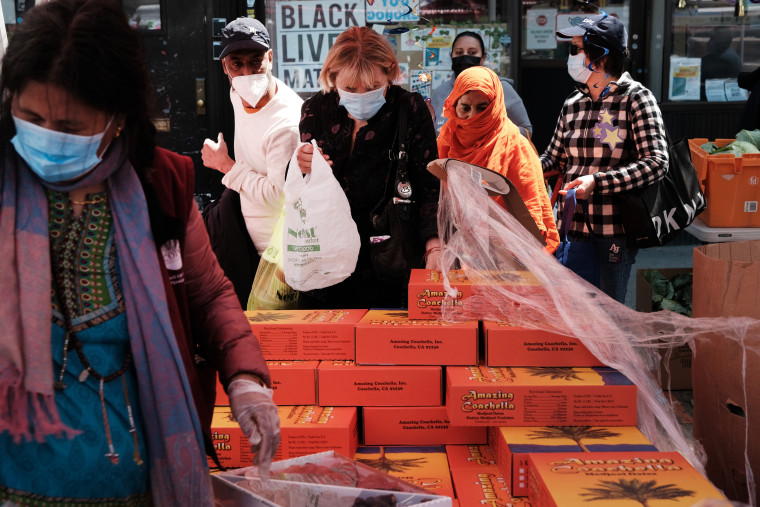In the wintertime, the road outside of Rawnak Jahan’s home in Queens, New York, is often covered in ice and snow. For the 63-year-old Bangladeshi immigrant, leaving the house and trekking to the grocery store might seem daunting in itself. But with a recent back operation leaving her unable to walk, food access is even more complicated.
“I am not able to cook because I cannot stand for a long time,” she told NBC Asian America. “After 10, 15 minutes, I have to sit down.”
Jahan, who came to the U.S. with her two children in 2015, relies on the community organization India Home to bring meals to her door. It’s not just sandwiches and canned goods, but food that reminds her of what she might make at home.
Experts say the holidays can pose challenges for many in Jahan’s position, who have the need but don’t know where to turn for support. And a general lack of understanding about the wealth disparity that exists under the “Asian American” umbrella might keep resources out of their reach.
Asians in the U.S. have the greatest wealth gap of any ethnic group, according to a 2018 report by the Pew Research Center. Those in the top 10 percent of income distribution earn almost 11 times as much as those at the bottom, a disparity that rapidly took shape from 1970 to 2016.
The average household income for Asians in 2019 was around $85,000. But without picking it apart, that figure paints an incomplete picture. Indian families in the U.S., the highest earners under the umbrella, make $119,000 a year on average. Burmese families represent the other end of the spectrum, with just $44,000 a year coming in. Bangladeshis like Jahan, concentrated in New York, have a median household income of $59,500.
But the $85,000 statistic is what gets the most traction, experts say, and that makes it so that government programs and charitable organizations are less likely to identify Asian communities to serve.
A lack of toys for lower-income Asian kids
In Los Angeles, a group of Asian Americans in business and law set up a holiday toy drive for this reason.
“Those larger toy drives did not seem to be providing toys to AAPI communities,” said Diane Tan, one of the founders of the APA Holiday Toy Drive. “That’s when we thought, we should try to at least provide some toys to children of low-income families in our own communities.”
The first one was held in 2000, with toys distributed to families through community organizations in their neighborhoods. Demand has only grown since then.
“Last year, the need was the largest we ever had,” she said. With 2020 decimating Asian-owned businesses with a combination of racism and Covid, Tan says the number of families signing up for toy donations has spiked. Company and individual donations have helped meet that need, but it’s a hard ask for a local organization.
“A lot of families, their income level went down and they’re not necessarily able to afford buying toys,” she said.
Food access and isolation in the winter months
The winter months in particular deepen food insecurity issues for lower-income Asians, according to community activists. There are several obvious barriers to entry, harsh weather conditions being one of them.
“They try to stay home and ration their food,” said Shubhra Datta, a case manager at India Home, which serves South Asian seniors in New York.
Of the 1,500 people who are members at India Home, 20 percent continuously experience food insecurity. Language barriers and lack of technology are two year-round hurdles that keep seniors from applying for programs like SNAP or food stamps.
“And then there’s people who have all those answers, but they can’t go outside, they can’t find the right type of food,” he said. “Most of them are from South Asia, they want food that’s South Asian, but it’s hard for them to find that.”
For elders with mobility issues, leaving the house to go to food banks might be impossible, and when they get there, they might be met with goods they don’t recognize. India Home tries to fill that gap by providing multiple free meals per week, consisting of rice or chapatis, halal meats, dal and a vegetarian dish provided by local restaurants.
“That is where you really help them feel seen, help them feel like they’re being treated with respect, with empathy,” said Deepti Sharma, who has worked in community food access for years.
Considering culture when providing meals is just the human thing to do, she said.
“The most important thing I wanted to accomplish was making sure people don’t feel like they’re getting a handout,” Sharma said. “But when you give them a bag of produce, it’s like they’re taking home something they can provide for their family. Now they can go home and cook a meal.”
India Home also takes into account health issues that are common to seniors, using brown rice instead of white rice so the meals are more nutrient-dense. Beyond keeping them fed, the good food also helps their mental health.
“If you’re well fed, you tend to forget a lot of other things,” Datta said.
Jahan misses Bangladesh; her husband still lives there and visits the U.S. only a few times a year. But she says she’s found her community here now. Before the pandemic shut down most in-person activities, she would write poems and recite them to other seniors at India Home. Even confined to her house, she still talks to those friends on the phone regularly.
“They made me welcome,” Jahan said.

